Stercorariidae – Skuas or Jaegers
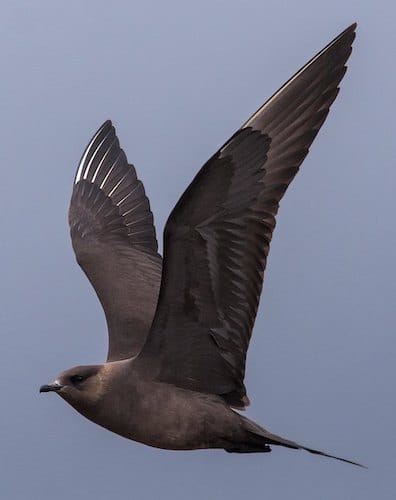
The Stercorariidae (Skuas or jaegers) are a group of seabirds in one genus, Stercorarius. The family is related to the waders, but merits its own family. The order Charadriiformes also includes Pluvianellidae (Magellanic Plover), Chionidae (Sheathbills), Burhinidae (Thick-knees & Stone Curlews), Pluvianidae (Egyptian Plover), Ibidorhynchidae (Ibisbill), Haematopodidae (Oystercatchers), Recurvirostridae (Stilts & Avocets), Charadriidae (Plovers & Lapwings), Pedionomidae (Plains Wanderer), Thinocoridae (Seedsnipes), Rostratulidae (Painted Snipe), Jacanidae (Jacanas), Scolopacidae (Sandpipers), Dromadidae (Crab-Plover), Turnicidae (Buttonquails), Glareolidae (Coursers & Pratincoles), Alcidae (Auks) and Laridae (Gulls, Terns & Skimmers). Glareolidae contains two distinct groups, the pratincoles and the coursers.
They nest on the ground in temperate and Arctic regions, and are long-distance migrants. They have even been sighted at the South Pole.
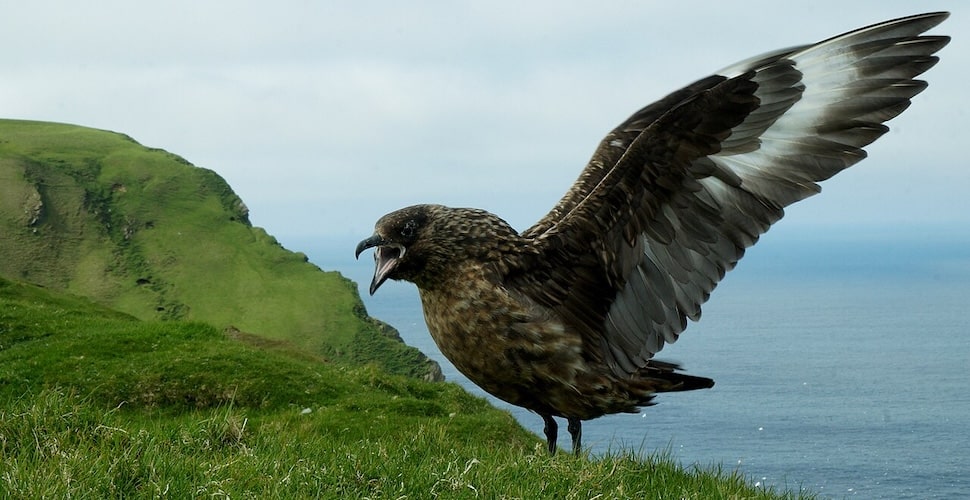
Great Skua Stercorarius skua – ©Mike Pennington CC BY-SA 2.0 via Wikimedia Commons
Outside the breeding season, skuas take fish, offal, and carrion. Many are partial kleptoparasites, comprising up to 95% of the feeding methods of wintering birds, by chasing gulls, terns and other seabirds to steal their catches, regardless of the size of the species attacked (up to three times heavier than the attacking skua). The larger species, such as the Great Skua, also regularly kill and eat adult birds, such as puffins and gulls, and have been recorded as killing birds as large as a Grey Heron. On the breeding grounds, the three, more slender northern breeding species commonly eat lemmings. Those species that breed in the southern oceans largely feed on fish that can be caught near their colonies. The eggs and young of other birds are an important food source for most skua species during the nesting season.
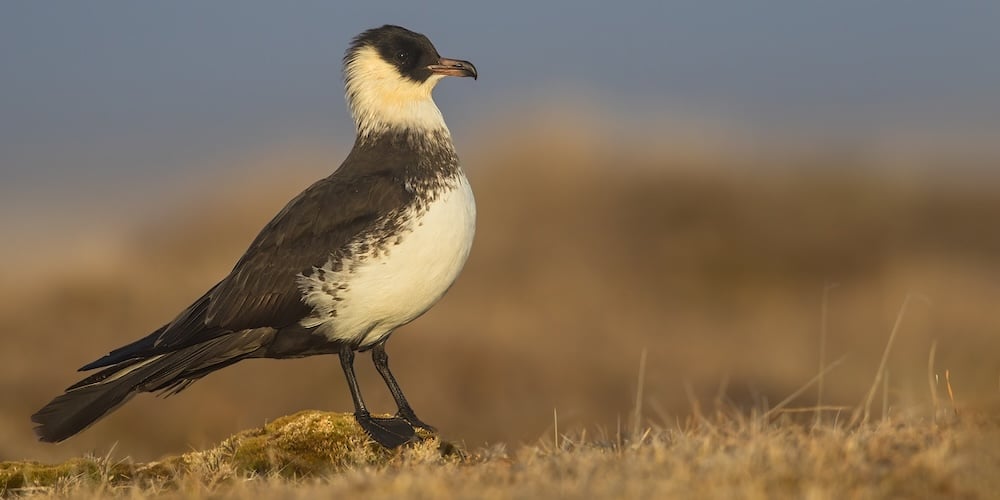
Pomarine Skua (Jaeger) Stercorarius pomarinus – ©Dubi Shapiro
In the southern oceans and Antarctica region, some skua species (especially the South Polar Skua) will readily scavenge the carcasses at breeding colonies of penguins and pinnipeds, sometimes taking live penguin chicks. In these areas, skuas seem to defer to the considerably larger giant petrels.
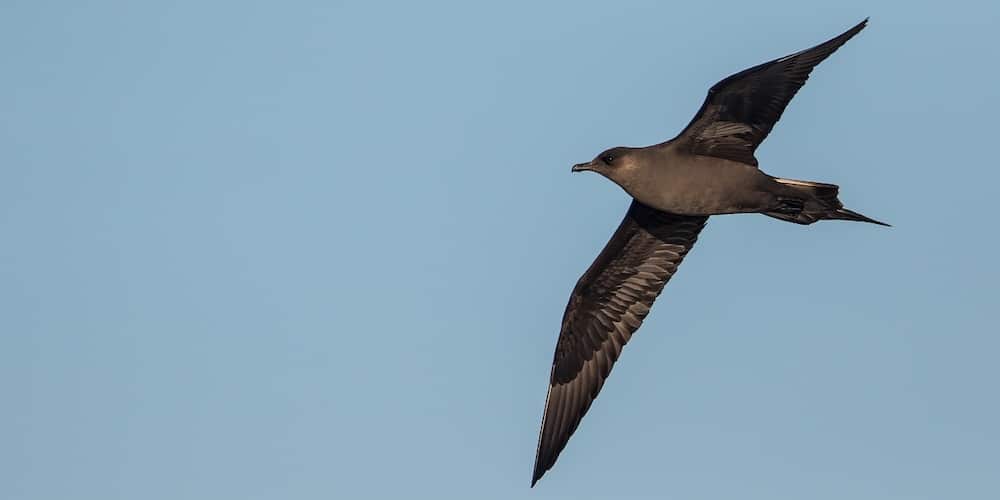
Arctic Skua (Parasitic Jaeger) Stercorarius parasiticus – ©Dubi Shapiro
They are medium to large birds, typically with grey or brown plumage, often with white markings on the wings. The skuas range in size from the Long-tailed Skua Stercorarius longicauda, at 310 grams, to the Brown Skua Stercorarius antarcticus, at 1.63kg. On average, a skua is about 56cm long, and 121cm wingspan. They have longish bills with a hooked tip, and webbed feet with sharp claws. They look like large dark gulls, but have a fleshy cere above the upper mandible.
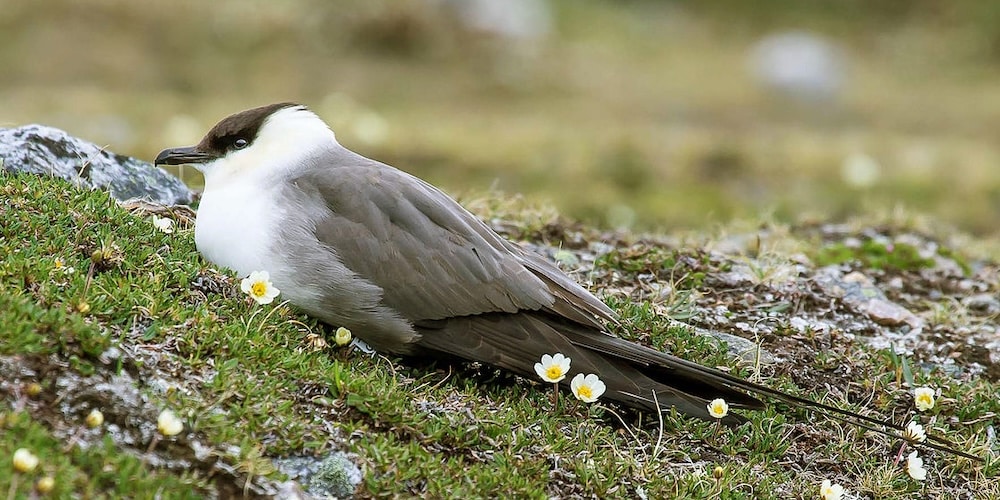
Long-tailed Skua (Jaeger) Stercorarius longicaudus – ©Smudge 9000 BY-SA 2.0 via Wikimedia Commons
The skuas are strong, acrobatic fliers. They are generally aggressive in disposition. Potential predators who go near their nest will be quickly dived at by the parent bird, which usually targets the head of the intruder; a practice known as ‘dive bombing’.
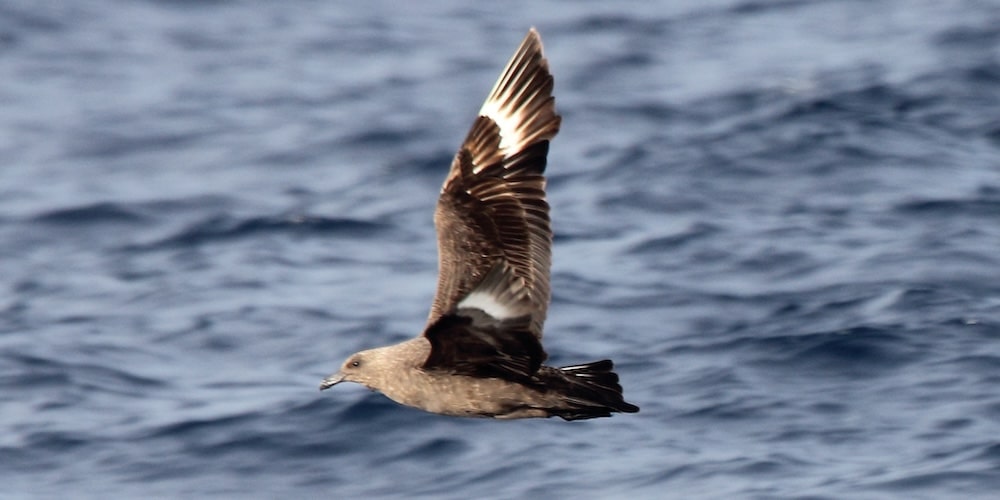
South Polar Skua Stercorarius maccormicki – ©Dominic Sherony CC BY-SA 2.0 via Wikimedia Commons
Skuas are related to gulls, waders, auks, and skimmers. In the three smaller species, all nesting exclusively in the Holarctic, breeding adults have the two central tail feathers obviously elongated, and at least some adults have white on the underparts and pale yellow on the neck. These characteristics are not shared by the larger species, all native to the Southern Hemisphere except for the Great Skua. Therefore, the skuas are often split into two genera, with only the smaller species retained in Stercorarius, and the large species placed in Catharacta. However, based on genetics, behaviour, and feather lice, the overall relationship among the species is best expressed by placing all in a single genus. The Pomarine Skua’s and Great Skuas’ mitochondrial DNA (inherited from the mother) is in fact more closely related to each other than it is to either Arctic Skua or Long-tailed Skua, or to the Southern Hemisphere species. Thus, hybridisation must have played a considerable role in the evolution of the diversity of Northern Hemisphere skuas.
-
Number of bird species: 7
(As at September 2025)
According to the recently (2025) combined AviList there are just seven species , in one genus of Jaegers or Skuas recognised as part of the Stercorariidae family. They are:
Arctic Skua (Parasitic Jaeger) Stercorarius parasiticus
Long-tailed Skua (Jaeger) Stercorarius longicaudus
Pomarine Skua (Jaeger) Stercorarius pomarinus
Great Skua Stercorarius skua
South Polar Skua Stercorarius maccormicki
Chilean Skua Stercorarius chilensis
Brown Skua Stercorarius antarcticus
-
The Seabird Group
WebsiteThe Seabird Group, a registered charity, was founded in 1966 to promote and help coordinate the study and conservation of seabirds
-
Flight Identification of European Seabirds
| By Anders Blomdahl, Bertil Breife & Niklas Holmstrom | Christopher Helm | 2007 | Paperback | 374 pages, 690 colourphotos | ISBN: 9780713686166 Buy this book from NHBS.com -
Seabirds - a natural history
| By Anthony J Gaston | A&C Black | 2004 | Hardback | 222 pages, 22 colour plates, b/w photos, illustrations, figures | ISBN: 9780713665574 Buy this book from NHBS.com -
Skua and Penguin - Predator and Prey
| By Euan Young | CUP | 2005 | Paperback | 452 pages, 53 line illus | ISBN: 9780521018135 Buy this book from NHBS.com -
Skuas and Jaegers
| By Klaus Malling Olsen | Helm | 2013 | Hardback | 168 pages, 13 plates with colour illustrations; 155 colour and b/w photos and b/w illustrations; b/w maps | ISBN: 9781408189078 Buy this book from NHBS.com -
The Arctic Skua - A Study of the Ecology and Evolution of a Seabird
| By Peter O'Donald & Robert Gillmor | CUP | 2009 | Paperback | 324 pages, Figs, tabs | ISBN: 780521113342 Buy this book from NHBS.com -
The Skuas
| By Robert W Furness | T & AD Poyser Ltd (A & C Black) | 2010 | Hardback | 363 pages, b/w photos, b/w illustrations, tables | ISBN: 9781408136690 Buy this book from NHBS.com
-
Stercorariidae
Family AccountDiet and Foraging. Stercorariids have a varied diet of animal prey, opportunistically hunting, scavenging... -
Stercorariidae
Family AccountThe skuas are a group of predatory seabirds with seven species forming the genus Stercorarius, the only genus in the family Stercorariidae.
-
Arctic (Parasitic) Skua (Jaeger) Stercorarius parasiticus
Species AccountSlender gull-like seabird; the middle-sized of the three jaegers. Breeds on Arctic tundra; spends the rest of the year at sea. Difficult to separate from... -
Arctic (Parasitic) Skua (Jaeger) Stercorarius parasiticus
Species AccountSound archive and distribution map. -
Arctic (Parasitic) Skua (Jaeger) Stercorarius parasiticus
Species AccountThe parasitic jaeger (Stercorarius parasiticus), also known as the Arctic skua or parasitic skua, is a seabird in the skua family Stercorariidae. The word "jaeger" is derived from the German word Jäger, meaning "hunter". -
Brown Skua Stercorarius antarcticus
Species AccountLarge, dark brown skua with a very robust beak. Several subspecies vary in plumage from largely dark to mottled pale brown. -
Brown Skua Stercorarius antarcticus
Species AccountThe brown skua (Stercorarius antarcticus), also known as the Antarctic skua, subantarctic skua, southern great skua, southern skua, or hākoakoa (Māori), is a large seabird that breeds in the subantarctic and Antarctic zones and moves further north when not breeding. -
Brown Skua Stercorarius antarcticus
Species AccountSound archive and distribution map. -
Chilean Skua Stercorarius chilensis
Species AccountRather large, dark, stocky gull-like seabird with big white wing patches (seen in flight). In summer often seen flying over Patagonian steppe or associating... -
Chilean Skua Stercorarius chilensis
Species AccountThe Chilean skua, also called the cinnamon skua (Stercorarius chilensis), is a large predatory seabird, which breeds in Argentina and Chile, but ranges as far north as Brazil and Peru when not breeding. -
Chilean Skua Stercorarius chilensis
Species AccountCatharacta chilensis is listed as Least Concern. -
Chilean Skua Stercorarius chilensis
Species AccountSound archive and distribution map. -
Great Skua Stercorarius skua
Species AccountThe great skua (Stercorarius skua) is a large seabird in the skua family Stercorariidae. -
Great Skua Stercorarius skua
Species AccountSound archive and distribution map. -
Long-tailed Skua (Jaeger) Stercorarius longicaudus
Species AccountSkuas are strong-flying piratical seabirds allied to gulls. The long-tailed skua is the smallest of the three holarctic-breeding skua species that regularly visit New Zealand. -
Long-tailed Skua (Jaeger) Stercorarius longicaudus
Species AccountSound archive and distribution map. -
Long-tailed Skua (Jaeger) Stercorarius longicaudus
Species AccountSlender gull-like seabird; the smallest of the three jaegers. Breeds on Arctic tundra; spends the rest of the year at sea. -
Long-tailed Skua (Jaeger) Stercorarius longicaudus
Species AccountStercorarius longicaudus is listed as Least Concern. -
Long-tailed Skua (Jaeger) Stercorarius longicaudus
Species AccountThe long-tailed jaeger (Stercorarius longicaudus), known as the long-tailed skua outside the Americas, is a seabird in the skua family Stercorariidae. -
Pomarine Skua (Jaeger) Stercorarius pomarinus
Species AccountBulky gull-like seabird; the largest and most barrel chested of the three jaegers. Breeds on Arctic tundra, spends the rest of the year at sea. -
Pomarine Skua (Jaeger) Stercorarius pomarinus
Species AccountThe pomarine skua (Stercorarius pomarinus) or pomatorhine skua, known as pomarine jaeger in the Americas, is a seabird in the skua family Stercorariidae. It is a migrant, wintering at sea in the tropical oceans. -
Pomarine Skua (Jaeger) Stercorarius pomarinus
Species AccountStercorarius pomarinus is listed as Least Concern. -
South-polar Skua Stercorarius maccormicki
Species AccountSkuas are similar to jaegers but are bulkier, thicker-necked, and with more prominent wing patches. South Polar Skua is similar to Great Skua but lacks heavy streaking on the body and wing coverts and lacks reddish-brown tones to plumage instead being dark brown to grayish… -
South-polar Skua Stercorarius maccormicki
Species AccountBulky cold-brown seabird with white wing flashes. Usually seen singly in strong and direct flight, sometimes resting on the ocean with rafts of shearwaters. -
South-polar Skua Stercorarius maccormicki
Species AccountCatharacta maccormicki is listed as Least Concern. -
South-polar Skua Stercorarius maccormicki
Species AccountSound archive and distribution map.
-
Skuas and Jaegers of the World
Facebook GroupMembers from all over the world are welcome to share photos of, discuss, and share sightings of Skuas and Jaegers.
